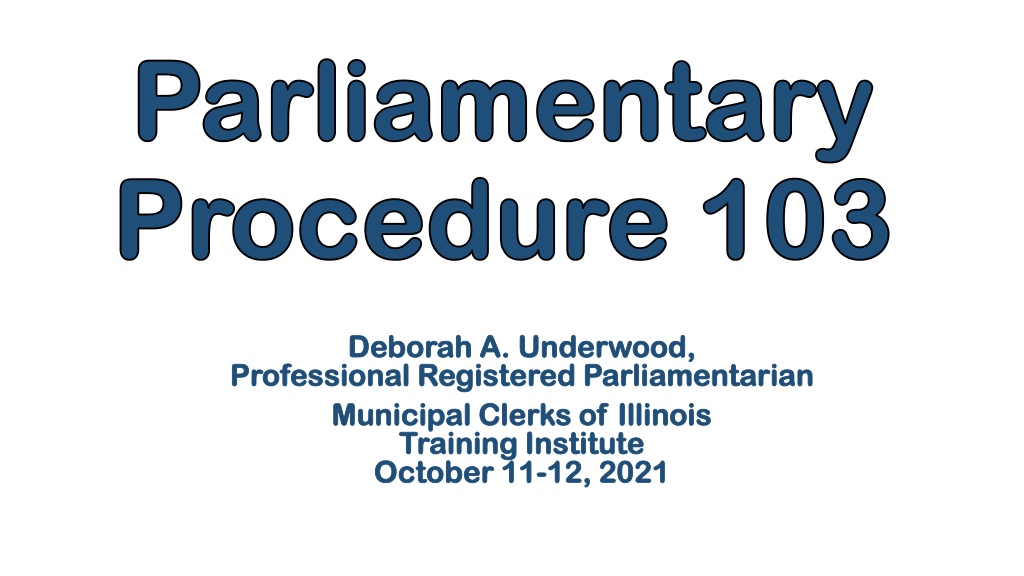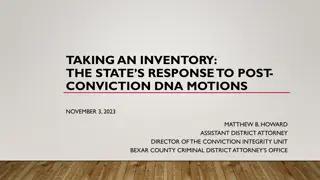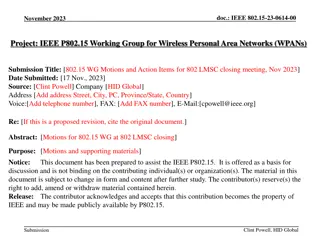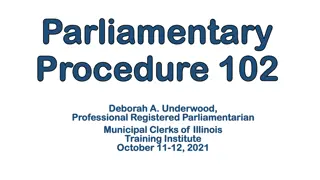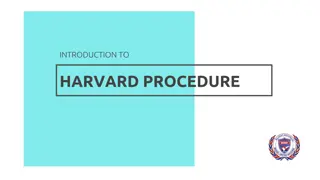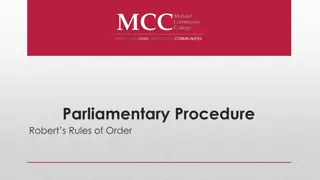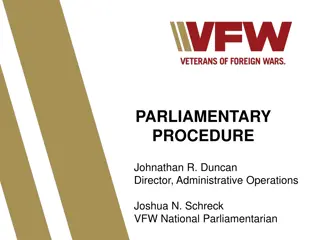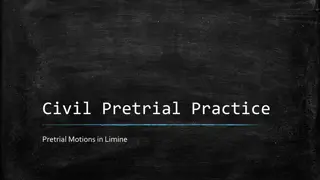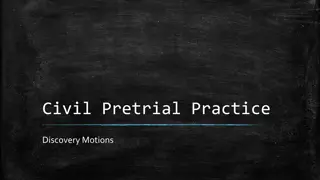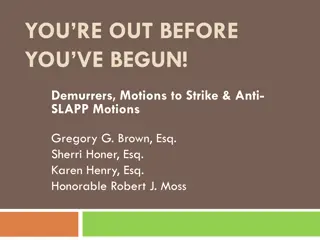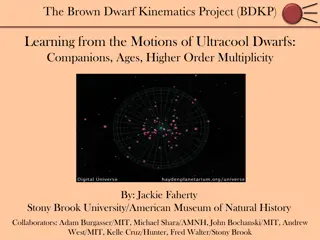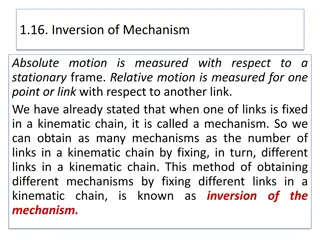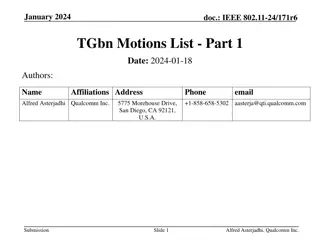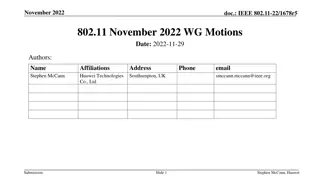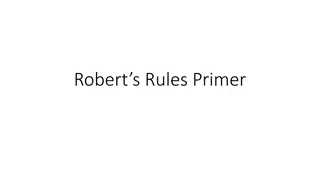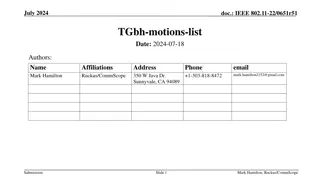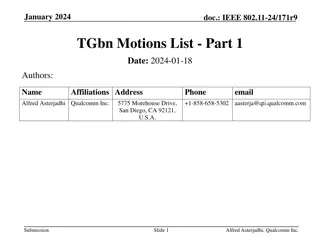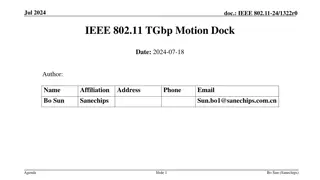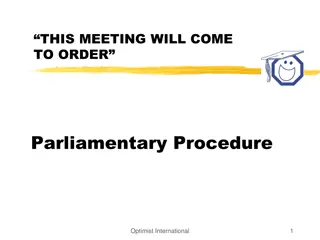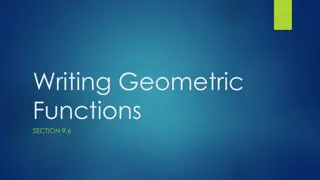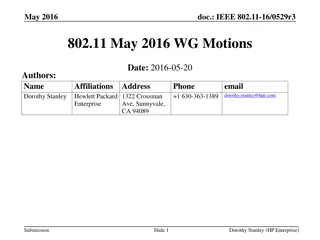Understanding Parliamentary Procedure and Main Motions
Explore the world of parliamentary procedure with insights into main motions, resolutions, classes of motions, and motions that bring a question back before the assembly. Learn about the hierarchy of motions, the process of introducing a subject in a meeting, and the significance of resolutions in formal discussions. Discover the structure and importance of different types of motions in parliamentary settings.
Download Presentation

Please find below an Image/Link to download the presentation.
The content on the website is provided AS IS for your information and personal use only. It may not be sold, licensed, or shared on other websites without obtaining consent from the author. Download presentation by click this link. If you encounter any issues during the download, it is possible that the publisher has removed the file from their server.
E N D
Presentation Transcript
Parliamentary Parliamentary Procedure 103 Procedure 103 Deborah A. Underwood, Deborah A. Underwood, Professional Registered Parliamentarian Professional Registered Parliamentarian Municipal Clerks of Illinois Municipal Clerks of Illinois Training Institute Training Institute October 11 October 11- -12, 2021 12, 2021
Parliamentary Parliamentary Procedure Procedure
Classes of Motions Classes of Motions
Classes of Motions Main motion Subsidiary Motions Privileged Motions Ranking Motions Non-Ranking Motions Incidental Motions Motions that Bring a Question Again Before the Assembly (Bring Back Motions)
Motions After a quorum is established, items of business on the agenda are handled by members offering motions. A subject is introduced by a member who makes a motion. After the motion is stated by the chair, the members discuss the motion.
The Main Motion A motion that is made when no other motions are pending. The main motion is the lowest ranking motion. Ranking motion #1 1. Original Main Motion Is a motion that introduces a question as a new subject to the assembly. RONR (12th ed.) 10:3 2. Incidental Main Motion A main motion that is incidental to or relates to the business of the assembly, or its past or future action. RONR (12th ed.) 10:4
Resolutions A complex question that is presented in writing either because of its importance or because of its length or complexity. Whereas, The (the first preamble clause). Whereas, The (the last preamble clause). Resolved, That (States the action to be taken). Resolved, That (States further action to be taken). Resolved, That (States still further action to be taken).
Motions That Bring a Question Again Before the Assembly This class of motions brings back before the assembly, business that has already been adopted. There is no ranking among these motions, and their order here is as listed in Robert s Rules of Order, Newly Revised. During the meeting or substantially the same question cannot be brought up again except through special procedures.
Subsidiary Motions A subsidiary motion assist the assembly in treating or disposing of a main motion. It is always applied to another motion while that motion is pending. Can be applied to any main motion. It is a ranking motion, so it follows the order of precedence.
The Ranking Motions Lay on the Table Previous Question Limit or Extend Limits of Debate Postpone to a Certain Time/Definitely Commit or Refer Amend Postpone Indefinitely MAIN MOTION SUBSIDIARY MOTIONS
Privileged Motions Deals with matters of immediate importance. Privileged motions do not relate to the pending business. Take precedence over all the lower ranking motions. (the main motion, all subsidiary motions, and lower ranking privileged motions)
The Ranking Motions (contd) Fix the Time to Which to Adjourn Adjourn Recess Raise a Question of Privilege Call for the Orders of the Day PRIVILEGED MOTIONS
Incidental Motions An incidental motion is related to the parliamentary situation so that it must be decided before business can proceed. The apply only under special circumstances. Incidental motions are NOT ranking motions
Motions That Bring a Question Again Before the Assembly While a question is temporarily disposed of, but is not finally settled, no similar or conflicting motion whose adoption would restrict the assembly in acting on the first question can be introduced To change what the assembly has adopted requires more (A previous notice to the members that this is coming back for a vote) and the vote is more than was necessary to adopt it in the beginning.
The Bring Back Motions Take from the Table Rescind or Amend Something Previously Adopted Discharge a Committee Reconsider Renew = An Unclassified Motion
STARRING STARRING Reconsider Rescind Renew
RECONSIDER The motion Reconsider is a motion to consider a second time the vote on a previously adopted or defeated question.
The Rules to Reconsider It is in order for any council member voting in the majority (on the prevailing side) to move for reconsideration of the vote on any question at the meeting or at the next succeeding meeting of the council.
The Rules to Reconsider(contd) Cannot be used for an affirmative vote if it has been partly carried out. Making the motion has time limits: Session of one day, on the same day Session of more than one day, the same day or the next succeeding day which a business meeting is held.
The Rules to Reconsider(contd) Can be applied to the vote on any motion with the exception of: A motion that can be renewed. A negative vote on a motion which, at the time of the motion to Reconsider is made, would be out of order because: 1. It conflicts with a motion previously adopted and still in force. 2. Cannot be used for an affirmative vote if it has been partly carried out.
The Rules to Reconsider(contd) If the original motion was debatable, the motion to Reconsider is debatable. It requires a two-thirds vote to adopt. If adopted, the original vote is completely erased. If it is voted on and lost, the motion to Reconsider cannot be renew except by Unanimous Consent. No question can be Reconsidered twice unless it was materially amended during its first reconsideration.
Reconsider and Enter On the Minutes Can be moved only on the same day that the vote to be reconsidered was taken. Can be applied only to votes that finally disposed of a main motion. Usually, cannot be called up on the same day the original vote was taken on the motion to be considered. Takes precedence over Reconsider
RESCIND Rescind is an incidental motion to annul or repeal action that was previously adopted.
The Rules to Rescind To entirely strike out a main motion, resolution, rule, bylaw, section or paragraph that has been previously adopted, a motion to Rescind can be made. If it is desired instead to change the previously adopted business, the previous action or order can be canceled or countermanded. The effect of Rescind is to strike out an entire main motion, resolution, order, or rule that has been adopted at some previous time.
The Rules to Rescind (Contd) A prior action cannot be rescinded when: It was previously moved to reconsider but the motion to Reconsider has not been called. Something done is impossible to undo; however, the unexecuted portion can be rescinded.
RENEW Renew is a motion that is made and disposed of without being adopted and is later allowed to come before the assembly after being made again by any member in essentially the same connection, the motion is said to be renewed.
The Rules to Renew A previously considered motion may become a substantially different question through a significant change in the wording or because of a difference in the time or circumstances in which it is proposed. A motion that is lost may be introduced at subsequent meeting, so long as its reintroduction does not become dilatory in nature. The rules restricting renewal of motions do not apply to any motion that was last disposed of by being withdrawn.
The Rules to Renew (Contd) The rules restricting renewal of motions also do not apply to any motion that does not receive a second. Such a motion is a motion which the assembly was not called upon to decide. The rules restricting renewal of motions do not apply to any motion that was last disposed of by being withdrawn.
Questions & Answers Questions & Answers
Resources Resources Robert s Rules of Order, Newly Revised 12th Edition Robert s Rules of Order, Newly Revised In Brief 3rd Edition Parliamentary Procedure in Local Government 3rd Edition
